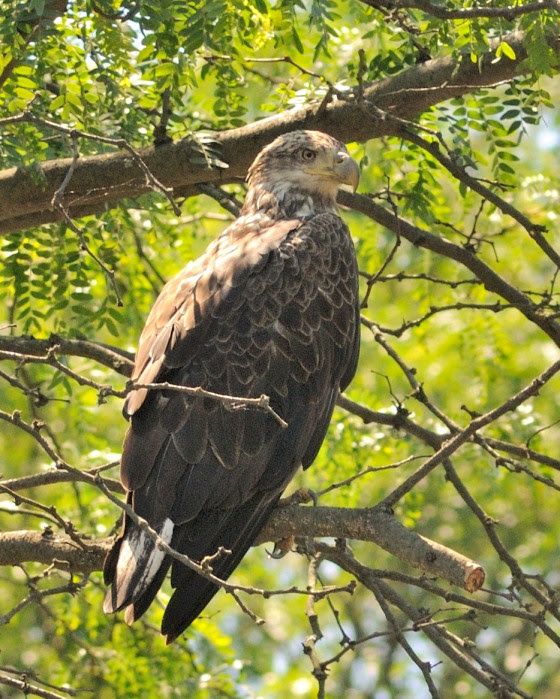The Eagle Has Landed
Article and photos by Joe Mish
It was a fine day on the river, blue sky, light breeze, air temperature in the 60s, and a perfect water level.
Having paddled several times a week throughout the winter in preparation for a canoe race in Maine, this mid spring post-race trip down the South Branch was a soothing balm to mind and body.
After the trout season opener, the South Branch was closed to fishing on Tuesdays during in-season trout stocking. So, Tuesdays were my choice to paddle and be assured no human company would spoil the sense of wilderness the river trip provided.
Though not in race mode, the smooth rhythm of my paddle stroke and resultant speed was mesmerizing as well as a distraction. I would zone out as if each stroke was a repetitive chant in a litany. So, for short periods, my attention would drift away from observing the world around me. Who knows how many deer or mink watched from the woody bank as I passed within yards of their position?
On a long straightaway, as I transitioned from hypnotic state to consciousness, I was shocked to see a very large raptor sunning on an overhanging dead branch under which I would pass. The sun silhouetted the bird as I traded paddle for camera and a chance at a very close photo op. I set the course with one hand on the paddle and the other holding the camera. Keeping movement to a minimum was critical as the canoe drifted perfectly into position. The bird seemed huge as the distance closed. I figured the ‘hawk’ would soon fly off, but to my surprise it tolerated my presence. I turned the canoe to face upstream and take more images. The ‘hawk’ spread its wings to sun itself but gave no intention of flying away.
For the rest of the trip, I kept wondering about the size of the bird and extra large beak, never thinking it was an eagle. Eagles were not a possibility, at least on the course of the river from Clinton to South Branch. Eagles frequented the upper Delaware and weren’t that commonly seen and never on the South Branch. Aside from no known local eagle sightings, this bird was primarily brown, and everyone knows bald eagles have white heads and tail feathers.
The closer I looked at the images later that day; it became clear the ‘hawk’ was a year-old bald eagle!
Even the celebrated nest at Duke Farms, discovered in 2004, was thought at first to be an osprey nest.
Bald eagle fledglings start out covered with brown feathers. Each year more mottled white appears on their body and not until their third year does the head and tail begin to turn white, though still marked with brown streaks. To see an illustration of plumage changes by year, check out avianreport.com.
My eagle 2011 encounter was a prelude to the construction of a nest on the lower South Branch of the Raritan in 2014. That nest has fledged eleven more eagles to cast a shadow over the wilds of New Jersey and states far beyond. Last year an eagle banded in 2017 on the South Branch, was seen paired with another eagle in Connecticut on the Connecticut River
Today eagles are a common sight along many of our major waterways. Given that the bald eagles’ characteristic pure white head and tail do not emerge until they are three and a half years old, juvenile eagles are easily mistaken for hawks.
Consider, you may have been given the privilege to see an eagle and not known it. If able to get a close look, see that its beak in comparison to any other hawk is huge. Keep an open mind to unexpected possibilities and know, for that reason, many self professed birders have missed the thrill of seeing their first eagle.
Author Joe Mish has been running wild in New Jersey since childhood when he found ways to escape his mother’s watchful eyes. He continues to trek the swamps, rivers and thickets seeking to share, with the residents and visitors, all of the state’s natural beauty hidden within full view. To read more of his writing and view more of his gorgeous photographs visit Winter Bear Rising, his wordpress blog. Joe’s series “Nature on the Raritan, Hidden in Plain View” runs monthly as part of the LRWP “Voices of the Watershed” series. Writing and photos used with permission from the author. Contact jjmish57@msn.com. See more articles and photos at winterbearrising.wordpress.com.


